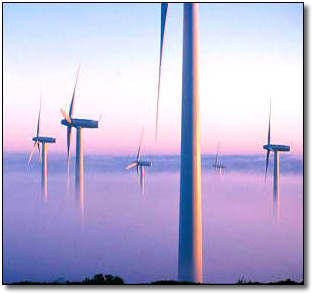
February 23, 2005
Photo: EWEA

|
February 23, 2005 Photo: EWEA |
"Tourists in many parts of the country often go
out of their way to visit wind farms."
- Laurie Jodziewicz, AWEA Communications & Policy Specialist
Increasingly, opponents of wind power resort to repeating common myths about the technology and its impacts. This article is the second in an occasional series from the American Wind Energy Association (AWEA) aimed at debunking those myths with the facts.
In most cases, wind power costs more than electricity supplied using
traditional fossil-fuel generation. However, the cost of wind power has dropped
dramatically - by almost 90 percent - over the past 20 years. Today, wind power
can be competitive with fossil-fuel generators if stable, supportive policies
are in place. And the benefits of wind power projects to local communities can
be seen across the U.S.
As has been experienced by the entire industry, the absence of the renewable
energy production tax credit (PTC) can bring the wind business to a halt. The
PTC now provides a 1.8-cent/kWh tax credit (adjusted annually for inflation) for
electricity generated with wind turbines, yet the most recent extension only
continues through December 31, 2005. Over the past five years, the PTC has been
extended three times. Each extension has nominally been for two years, although
it has often seemed even shorter in practice because developers cannot move
forward until the law is certain. This robs the industry of stable financial
expectations for future projects. This "on-again, off-again" approach
hobbles individual projects and the industry as a whole.
The fact that wind power receives this tax credit is often used against wind
energy projects. Yet tax credits are common in the energy sector because energy
is vital to the economy and everyone has an interest in diversity of fuels. The
U.S. government provides subsidies and tax breaks to all kinds of electricity
sources, including traditional fuels such as coal, nuclear, and natural gas. A
report prepared for the National Commission on Energy Policy found a low-end
estimate for federal energy subsidies in 2003 to be $37 billion to $64 billion.
Total wind energy PTC payments in that same year are estimated at $155 million -
well under 1 percent of the energy subsidy total. The wind industry is not
asking for a special handout; we simply want a level playing field.
Another argument made against wind farms generally is that they harm local
economies through impacts on property values or tourism. Both of these claims
are false. The only serious U.S. studies done on wind projects and property
values discovered no impact. Statements to the contrary do not represent
real-world experience.
Tourists in many parts of the country often go out of their way to visit wind
farms. Local governments frequently work with developers to install information
stands and signs near wind farms, as well as pull-off areas similar to
"scenic overlooks" from nearby roads. The thousands of turbines in
Palm Springs, California, have had no negative impact on the tourism business;
on the contrary, the local tourism center organizes bus tours to the wind farms.
In New York, a wind project in Madison County actually attracts tourists. The
local Chamber of Commerce fields many questions about the project and provides
directions on how to get to it.
In addition to providing emissions-free electricity, wind farms create local
economic benefits in the form of jobs and tax payments. Many people in the
industry are familiar with the overwhelmingly positive impacts wind projects
make on rural communities, but those unfamiliar with wind energy may look at
developers skeptically. Skeptics should consider just two persuasive examples:
In southeast Colorado, Prowers County sales tax collection rose by almost 62
percent in the year during construction of a 162-MW wind farm. Operation of the
wind farm adds 15-20 good jobs in the area. And the county's tax base rose by 29
percent, providing hundreds of thousands of dollars to local schools and medical
centers.
Tucker County, W.V., has seen more than $700,000 contributed to the local and
state economies in the two years since construction of a 66-MW wind farm there.
In addition, the county saw an increase in tourism in 2004. As in New York's
Madison County, local press coverage indicates that one of the most frequent
questions at the local visitor's bureau is from tourists wanting to know more
about the wind farm and how to get there.
Wind power projects are strongly beneficial to the local economy, boosting the
tax base and helping family farmers stay on the land.
For more information on wind energy's economics, click on AWEA's fact sheet at
the following link:
Please Note: RenewableEnergyAccess.com and Arizonaenergy.org do not endorse the sites behind these links. We offer them for your additional research. Following these links will open a new browser window.
Copyright © 1999 - 2004 - RenewableEnergyAccess.com
Please visit www.RenewableEnergyAccess.com for great coverage on energy today!!